GRAPH LEGEND
Node > 980 Ti - GeForce GTX 980 Ti (6GB) GPU installed in the AKiTiO Node Thunderbolt 3 eGFX Box
Node > TITAN - GeForce GTX TITAN X (12GB) GPU installed in the AKiTiO Node Thunderbolt 3 eGFX Box
Node > 980 - GeForce GTX 980 (4GB) GPU installed in the AKiTiO Node Thunderbolt 3 eGFX Box
Node > 780 - GeForce GTX 780 (6GB) GPU installed in the AKiTiO Node Thunderbolt 3 eGFX Box
Node > 680 - GeForce GTX 680 'Mac Edition' (2GB) GPU installed in the AKiTiO Node Thunderbolt 3 eGFX Box
Pro 460 - Factory discrete AMD Radeon Pro 460 (4G) GPU inside the 'late 2016' MacBook Pro
Test Mule: 'late 2016' Retina MacBook Pro 15-inch, 2.9GHz Core i7-6920HQ, 16G of 2133MHz LPDDR3 memory, AMD Radeon Pro 460 (4G) GPU, 1TB flash storage.
The AKiTiO Node eGFX Box's Thunderbolt 3 port was connected to the Thunderbolt 3/USB-C port of the MacBook Pro. The DisplayPort of each NVIDIA GPU was connected to the Dell 5K 27" display's DisplayPort. When testing the Pro 460 GPU, the MacBook Pro was connected to the LG UltraFine 5K display using a Thunderbolt 3/USB-C cable.
Blender - Lets you choose either OpenCL, CUDA, or CPU to render a 3D Scene. The factory Radeon Pro 460 rendered the BMW GPU Demo scene using OpenCL. All the NVIDIA GPUs in the Node eGPU rendered using CUDA.
(LOWER time in seconds = FASTER)
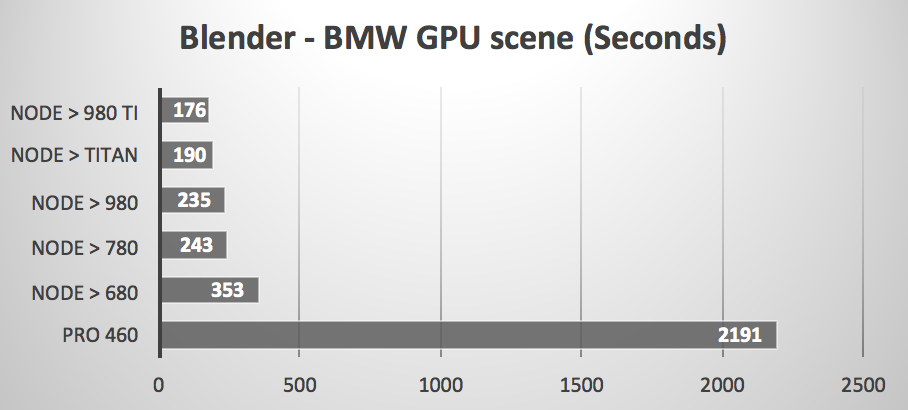
OctaneRender
This is a "GPU only" standalone renderer that can process scenes created in Maya, ArchiCAD, Cinema 4D, etc. -- and does so in a fraction of the time it takes with a CPU based renderer. However, it only runs only on CUDA capable NVIDIA graphics cards. We used the DEMO version with a test scene called octane_benchmark.ocs. For our test we selected RenderTarget PT (Path Tracing).
(LOWER time in seconds = FASTER)
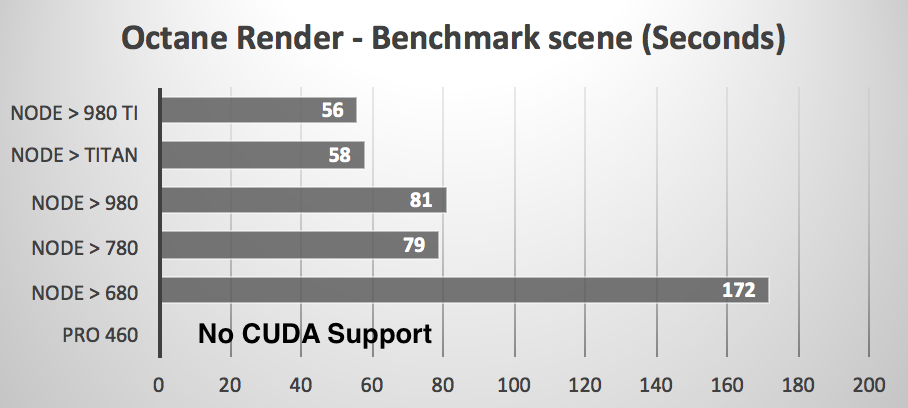
DaVinci Resolve - Candle project playback renders Noise Reduction Node (1NR) on-the-fly. The factory Radeon Pro 460 rendered using OpenCL. All the NVIDIA GPUs in the Node eGPU rendered using CUDA.
(HIGHER frames per second = FASTER
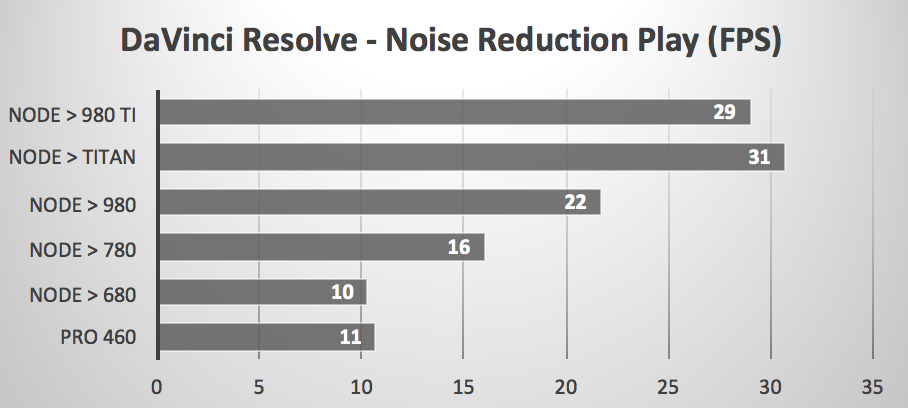
Geekbench 4 GPU Compute Benchmark - The factory Radeon Pro 460 rendered using OpenCL. All the NVIDIA GPUs in the Node eGPU rendered using CUDA.
(HIGHER score = FASTER)
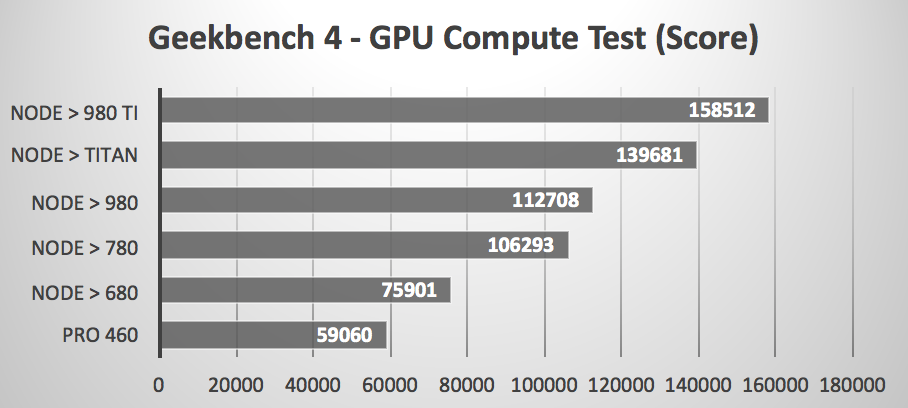
LuxMark 3 OpenCL - Both the factory Radeon Pro 460 inside the MacBook Pro and all the NVIDIA GPUs in the Node eGPU rendered using OpenCL.
(HIGHER KSamples per Second = FASTER)
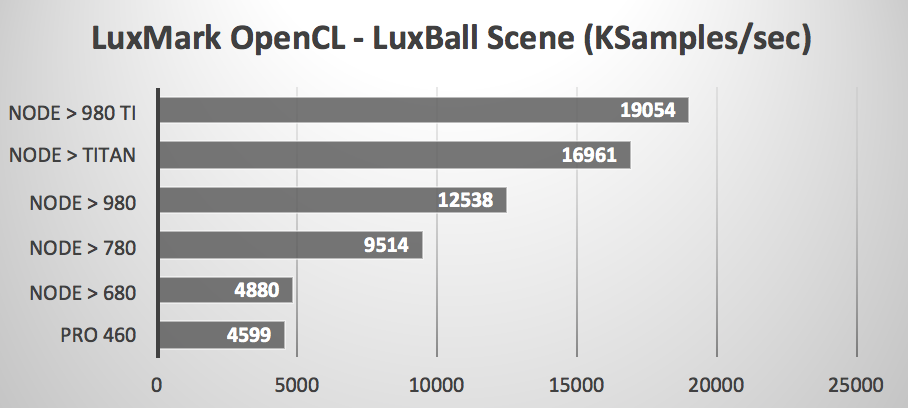
Valley OpenGL Benchmark using Extreme HD Preset
(HIGHER frames per second = FASTER)
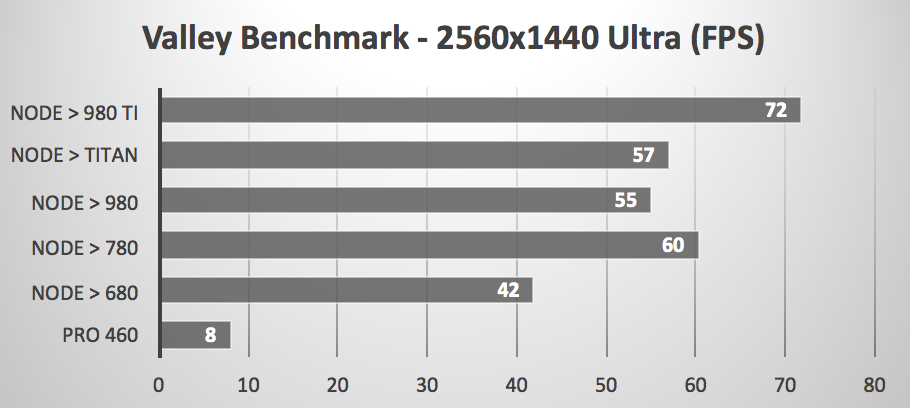
Tomb Raider Built-in Benchmark using High Preset
(HIGHER frames per second = FASTER)
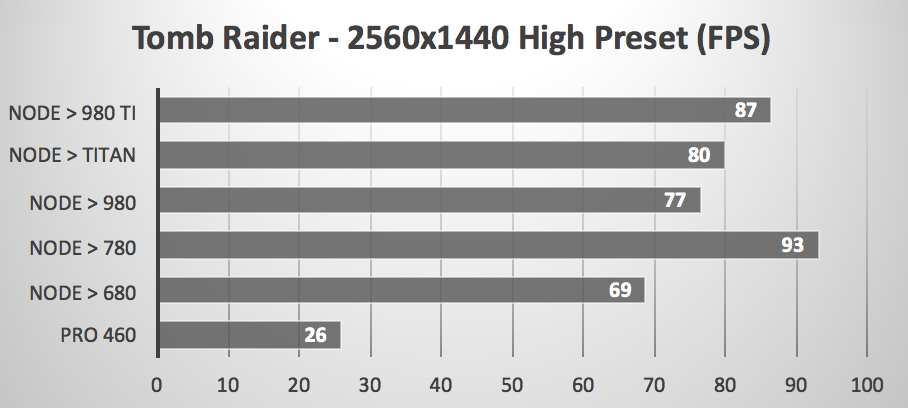
WHAT DID WE LEARN?
The AKiTiO Node eGFX Box is the first Thunderbolt 3 GPU expander we have tested that is macOS friendly, runs at full Thunderbolt 3 bandwidth, has a built-in power supply, and optional 2 meter Thunderbolt 3/USB-C cable. And with the array of compatible NVIDIA GPUs to choose from, you can be confident that it will not only support your CUDA capable apps, but will accelerate OpenGL and OpenCL capable apps beyond what the MacBook Pro's discrete AMD GPU is able to do.
Note that the TITAN GPU with its 12G of VRAM did best in the DaVinci Resolve test while the GTX 780 shined in the Tomb Raider test. In all other tests, the GTX 980 Ti excelled making it the best overall choice for your eGPU. If you are running some apps under Windows, it would be tempting to run the GTX 1080 in the Node. I just wish we had macOS drivers for that GPU!
"DO I NEED AN EXTERNAL DISPLAY?"
It depends on the apps you run. DaVinci Resolve, After Effects, Premiere Pro, Blender, Octane Render, and PhotoZoom all detected and allowed you to choose the CUDA capable NVIDIA GPUs without an external display connected. When the external display was absent or not set to primary, apps like FCPX, Photoshop, Lightroom, Tomb Raider (and other games) ignored the NVIDIA GPU in the Node.
THUNDERBOLT 3 ENABLER
To insure that all external Thunderbolt 3 devices we test are deemed 'supported' by System Profiler, we downloaded and ran the tb3-enabler.
RELATED ARTICLEs
See our test results with the Node eGFX Box connected to the 'late 2013' Mac Pro.
If you already own the BizonBOX 2 or 2S, you can use an adapter to connect it to the Thunderbolt 3 / USB-C port of the 'late 2016' MacBook Pro. We show those test results in a recent article.
Comments? Suggestions? Feel free to email me,
Follow me on Twitter @barefeats